Changi Airport, Singapore’s main and busiest international airport has a new 4th terminal under its management. Terminal 4 is its latest gem to date. I was there to check out what is new about the airport before its official opening. It is situated south of the current Changi airport Terminal 2 and beyond the SATS Inflight catering center compound. In perspective, the new Changi Airport Terminal 4 sits by itself where the old budget terminal building resided.
Construction milestones
On opening, Terminal 4 will serve both full-service and low cost carriers. The terminal is predicted to have an annual passenger movement capacity of 16 million. Henceforth, propelling Changi Airport’s total passenger capacity to 82 million annually.
Construction of the building complex commenced in early 2014 since its announcement in 2012 prior. In essence, it forms part of Changi airport’s long term expansion plans with the inclusion of the future Terminal 5. Terminal 4 was designed by SAA Architects and built at a cost just under $1 billion SGD (S$985 million). The facility itself was completed on 16 December last year and underwent extensive occupation for its opening this year.
Departure halls
A typical trip from the airport terminal begins at the Departure hall. Like the other 3 Changi airport terminals, the departure hall is located on the 2nd floor. Moreover, it is served by a vehicular on-ramp for drop-offs. Also, this conventional 2-floored airport terminal design is built above ground through and is over 25 meters in height.
This building arrangement allows for the passenger services, such as check-in counters, immigration and duty-free (international zone) areas to be located on this upper floor. The ground floor is dedicated to arrivals and logistical equipment. This includes areas for baggage sorting machinery which connects to the Aircraft ground handling areas on the other end of the building.
Lack of a viewing gallery
The thing I find strange is the absence of any public airplane viewing galleries in the departure halls. Which was quite a letdown. Watching planes taxing and taking off/landing had always been a fascination to watch since I was a kid. Sadly, the only viewing galleries are seemingly only those located at the gate level with the terminal transit area only.
Furthermore, the departure hall echoes design largely cues from Terminal 3, with large open, airy halls with a high ceiling. Notably, even the terminal glass entrance and glass elevators bear similar resemble to the tried and tested design of its older Terminal 3. Also, there is an abundance of natural light coming in through the roof skylights. Moreover, the amount of light is adequate for lighting up the cavernous terminal. However, you don’t get the smart louvers found in Terminal 3 which open and closes to optimize light conditions.
Panorama of Terminal 4 Departure hall
The terminal is cavernous, with an entire gross floor area of 225,000 square meters (about 27 football fields). The terminal departure pillars and walls are cladded with sleek modern metallic panels. Hence, giving the interior a very modern look.
Additionally, the check-in counters spots a rather minimalistic design in white which adds to the modern contemporary look. The departure complex flooring is laid out in polished tiles instead of carpets. Tiles are easier to maintain, clean (using robots) and are less prone to staining.
Terminal 4 adopts a red and purple hue colour scheme. Also, this colour scheme resonates into the fixtures and seating benches all around the terminal. Moreover, the seat benches on the public-side departure hall seating also spots universal 240-volt charging points and two USB 5v outlets per seat bench. This is handy for travelers looking for battery juice on the go.
Art at the Terminal
Changi airport is well renowned for their art installations in their terminals. Greeting you just by the departure entrance is the first art piece by French artist, Cedric Le Borgne, titled Les Oiseaux (The Birds). Moreover, the figures, made out of handcrafted stainless steel wires are hung from the ceiling suspended over the elevator connecting the 2nd floor to the arrival floor below. The wired sculpture beautifully depicts the scene of three birds in stages of motion of flight. The artworks are well suited for the aviation theme here.
At the far end of the departure hall is the immigration area and also where the centerpiece of Terminal 4 reside- the Petalclouds. Looking back, we had the kinetic rain in Terminal 1, the flowery robotic arms and green wall in Terminal 3, just to name a few. Terminal 4 brings the notch up further with a new moving work of modern art.
The Petalclouds kinetic sculpture
The Petalclouds is a grand-scale kinetic sculpture delivering a complex amalgamation of art, music and science. The sculpture is made out of sixteen triangular shaped rings. Each ring is suspended by 4 steel cables anchored to a cable reel from the ceiling. Here, two precision stepper motors, each driving 2 cables each. This allows for each petalcloud triangular “ring” to be independently raised, lowered and rotated by varying the length of cable between each of the two drive motors. In all, there are three main choreography patterns of the Petalclouds, its movement is synchronised to animated lighting and music.
When watched, the kinetic sculpture is both calming and memorizing. It is as if it has a mind of it’s own. The sculpture rings moves about independently from each other, forming up shapes in choreograph. Notably, there are four such Petalclouds installations here in Terminal 4.
The Petalclouds can be seen from the Departure Check-in Hall, Transit Area and Arrival Hall. These sculptures are suspended 200m across the Central Galleria. Also, this area is otherwise known as the terminal arrival baggage claim area too. It spans the height from ground floor-to-ceiling. A spectacular sight indeed.
The Petalclouds is a grand-scale kinetic sculpture delivering a complex amalgamation of art, music and science.
Self check-in counters
Terminal 4 touts the ability for jet-setters to self-check themselves in through a number of automated kiosks. These kiosks are where you can collect and print your flight boarding pass upon confirmation of your flight itinerary (usually through a flight booking reference and/or passport scan). Furthermore, Changi calls this new concept FAST@Changi. FAST meaning Fast And Seamless Travel. This is what the airport claims allows for self-service check-in; and automated bag drop, immigration clearance and boarding.
The self check-in counters spots a white sterile and minimalistic design. The counters are laid in rows over a carpeted area which helps in dampening noise from heavy luggage handling. The flooring at the departure hall here transitions from the polished tiles to a carpeted area at the check-in counters. If you had done an online/kiosk self check-in before, these machines are similar and not too different from your conventional kiosks found in airports around the world. However, you do get a ton loads of counters here, far more than those typically found in any airport. This greatly reduces manpower need as well as long queues for passengers to check-in.
Also, unlike most self-serve kiosks which are owned by the respective airlines, these ones here are owned and operated by Changi airport themselves. This allows for passenger service consistency. Cathay Pacific is first airline to operate out of Terminal 4, followed by Korean Air, Vietnam Airlines, AirAsia, Cebu Pacific and Spring Airlines.
Working the self-check in
You start off by tapping to wake up the Kiosk screen and select your airline. The machine will ask you to verify your ID by scanning your passport to match your registered name on your flight itinerary. Thereafter your boarding passes will be printed and dispensed allowing you to proceed onto immigration or baggage check-in (if you have large bags). However, there is currently no support for paperless E-boarding passes. These passes are virtual ones you can scan a QR code direct from the screen of your phone.
Self baggage deposit counters
In-addition to the self-check-in, the baggage self-help check-in are also one of the new features in Terminal 4, allowing you to weigh, tag and deposit your bag with minimal help from airport counter staff. Henceforth, this allows the airport to run more leanly. Terminal 4 was touted to do more with less, with about 16% more capacity than Terminal 3 per square area despite being half the physical size of Terminal 3.
Upon verifying your boarding pass and identity (via camera facial recognition), the machine will instruct you deposit your baggage on the self-check counter conveyor belt. Here, the self-help machine will weigh and register your baggage. Subsequently, it will automatically tag your bags to your boarding pass based on your luggage allowance specified by the airline and cabin class you are traveling. The machine will then proceed to print your bag tag. Thereafter, you have to manually affix to the handle of your luggage before sending it down the conveyor chute. Step instructions on-screen will guide you on the baggage and labeling process.
Moreover, if you have any special baggage requests or odd-sized luggage, conventional personnel-manned counter check-in are also available on-request.
Terminal automation and food kiosks
Automation is the name of the game in Terminal 4. Besides the automated check-in counters, the terminal employs a myriad of automation. This ranges from self-service food and drink kiosks, automated self-vending machines and even autonomous cleaning robots.
There are very few eateries and cafés in the departure lounge, with amenities largely provided for by self-service food kiosks. These automated vending machines are operated by Altas vending. Here, they offer a range of hot food, drinks and coffee machines at the public-facing departure areas. You can pay for your meals via cashless means, such as Ez-link of Visa Paywave.
Automation is the name of the game in Terminal 4, besides the automated check-in counters, the terminal employs a myriad of automation ranging from self-service food and drink kiosks, automated self-vending machines and even autonomous cleaning robots.
But personally as a traveler, nothing beats having to sit down in a restaurant after a long day of flying. Hence, I won’t see myself cramping into eating out of a vending machine just for the stake of automating food dispensing options. This feels somewhat cold and lacks the human touch. I do hope Terminal 4 do not want to destroy this traveling experience.
Immigration and passport control
At the end of the departure halls is the consolidated immigration and terminal security screening checkpoints. The main difference here is that all immigration, followed by airport passenger departure screening are all centrally done back to back here at one point in the terminal. This allows the consolidation of checkpoint authority resources in one main area of the departure terminal.
The white sterile minimalistic counter design is echoed throughout the building into the immigration counters. The immigration counters spots a combination of traditional immigration human counter clearance booths and automated two-stage self-service immigration gantries. The automated gantries is an improved model of the express passport clearance system which we are familiar with at all Immigration checkpoint authority (ICA) checkpoints in Singapore.
New consolidated security screening area
A large brightly animated LCD LED screen greets you at the immigration counter. It showcases various tourist scenes of interest in Singapore as passengers wait in the queues in the area.
Panorama of Immigration and LCD screen area
Terminal 4 is also the first terminal to fully utilize millimeter wave scanners, conventional gantry metal detectors and CT scanners computed tomography (CT) X-rays machines. In a nutshell, the millimeter wave scanner is a whole-body personnel imaging device used for detecting objects concealed underneath a person’s clothing using harmless electromagnetic radiation.
On security checks, you may be directed to either the conventional metal detector gantry or the millimeter scanner. In the latter, you have to hold your arms up above your head for 3 seconds where the machine sweeps around you to verify the absence of contraband items. Thereafter a member of the Immigration checkpoint authority staff will signal to you to leave the machine.
New CT Scanners
Additional new machine of interest here will be the CT scanners for your carry-on baggage. Unlike conventional X-ray scanners with only top and side views. Moreover, this scanner borrows technology from their medical counterparts using digital x-ray detectors located directly opposite the x-ray source.
Thus, this allow the CT machines to automatically generate cross-sectional images or “slices” of your carry-on baggage. Hence, it allows for greater visibility and clarity of its contents, speeding up verification and greatly reducing chances of false positives. Also, about time, the tray collection and return too are automated with an auto-reloading conveyor system with clearly marked large plastic trays.
Unlike having individual security scanning station at gates like those currently in Changi Terminal 1 to 3 (where you only have to deal with security queues with passengers from your flight). I find this consolidated security arrangement in Terminal 4 might create a central bottleneck as passengers from all gates will be cooped up here for screening. But the up-side is that there are plenty of screening counters here. Hence, this could expedite the immigration and security screening inflow into the transit areas.
Terminal Transit area
Following the immigration and security counters brings you straight into the transit area and duty-free. Unlike Terminals 1-3, where duty free shops are inconspicuously located by the sides of the transit lobby, all passengers in Terminal 4 have to walk through a snaking row of duty free shops before entering the central transit area.
The transit area is carpeted open, airy with a high ceiling similarly-lit like the departure hall using a combination of overhead lighting and skylights. Interestingly, even the carpets spots the shapes of the Petalclouds triangles, which resonates as the Terminal’s theme. Moreover, there are a variety of green features such as potted plants and a mini garden useful for jet-lagged passengers looking for relaxation spots.
Panorama of Petalclouds atrium
All seating here are rather comfy, with 240-volts charging points and USB outlets at every row of seats. A balcony seating area overlooking the arrival atrium is also present, allowing you to view the Petalclouds kinetic sculpture. An aluminum sculpture made by Swiss artist, Kurt Lawrence Metzler titled “The Travelling Family” resides here too.
The lower transit floors houses most duty free, shops and selling the usual fan-fare of duty-free and boutique products. This includes clothing apparel, bags alcohol and cosmetics. These shops line the walls of the transit area. Moreover, Changi Airport Group (CAG) claimed that it has over 80 concession contracts awarded to various retail and food and beverage outlets to run stores here. This includes and not limited to Charles & Keith, Coach & Furla, Gassan Watches and Michael Kors to name a few. Interestingly, there is even a tiger beer bar overlooking the arrival atrium. Also, the upper floors, accessible via escalators and elevators houses mainly Food and beverage outlets, such as restaurants, cafes and a 24 hour Singapore food street food court.
Here, there are several passenger comfort amenities such as showers, hot and cold water dispensers, Internet kiosks here, as well as 24/7 eating places. Flight departure info boards are situated everywhere about the terminal transit area at strategic locations. Furthermore, if you require any cash amenities, there are money changers and DBS ATM tellers within these transit areas too.
Transit Heritage Zone Corner
The Heritage area is one of my favorite sections of the transit area. Moreover, The centerpiece here is an open seating area filled with lounge chairs facing a decorative recreation of a Peranakan “five foot walkway” line of shop front. This shopfront can be typically found in the Singapore Chinatown or the Boat Quay area. This instantly recognizable feature is fully recreated here in the Heritage Zone. Also featured here are retail spaces hawking a line of traditional goods in the setting. Examples of merchants here include London Fat Duck, Old Street Bak Ku, with the exception of Sushi Goshin by Akashi.
A screen blended into the shop façade loops a 10 minute video run at the center of the Peranakan shop façade. This gives visitors a peek into the architecture and life within during the times. Additionally, the video was made in collaboration with Singapore composer Dick Lee, who is known for this array of uniquely Singapore songs. Check out the presentation in the video below:
Video of the Heritage Zone Corner
Terminal Gates
Terminal 4 adds to the capacity of Changi airport 21 additional Airplane contact gates (G1 to G21) and 8 additional bus gates. From this total, 17 gate stands (Gates G1 to G17) are dedicated for narrow body aircraft. Therefore, the gates can only be used by single-aisle aircraft such as the Airbus A320 & Boeing 737. Physically, the gates are located just off the Heritage zone. Here, a glass lined corridor facing the runway, taxiways and gates spans the entire length of the Terminal building.
4 stands, gates G18 to G21 are able to accommodate wide body aircraft (AWB) such as the A380, meaning that Terminal 3 won’t be the only Terminal able to serve AWB aircraft. Furthermore, these gates can serve both single-aisle & wide-bodied aircraft. Smaller single-aisle aircraft can also correspondingly utilise what Changi Airport calls the Multiple Aircraft Receiving Stands (MARS) at Gates G18 to G21 (designated as Gates G18L to G21R).
A new control tower
Miscellaneous works with respect to Terminal 4 includes a new dedicated 68 meter tall Air Control Tower and major airfield and taxiway works to upgrade existing infrastructure concurrently during the development of Terminal 4. The new control tower supplements the existing one in front of Terminal 1. It was built to enhance air traffic controller awareness over the Terminal 4 area and manage aircraft movements in the apron and taxiways around the remote terminal.
In addition, a 38-hectare land plot south of Terminal 3 was converted into an aircraft parking area. This sector is able to house additional 17 narrow-body and nine wide-body aircraft. The airport nursery and water reservoir used to reside here. Subsequently, this expansion stands to increase the number of aircraft parking stands supporting all airlines needs operating at Changi.
Hence, this increases the number of new aircraft stands by 24% to more than 180. These additional parking stands shall be served by a new overhead vehicular bridge across Airport Boulevard. Thus, it enables buses and other air-side vehicles to move from T4 to these aircraft aerobridge stands.
Terminal Connections
However, my only gripe about the new Terminal 4 is it remote-ness and its distance from the other terminals and MRT station. Given its inaccessible location away from Changi airport Terminals 1-3, Terminal 4 is remotely not even walkable from the other 3 terminals. This is until say, a new connecting sky train is introduced. Henceforth, it will probably form a looping network, synonymous to New York JFK airport which connects all of its 8 airport Terminals. This plan can be feasible to link with the future Terminal 5 expansions. Moreover, if you are driving, Terminal 4 has a dedicated above-ground multi-storey carpark as well as the departure off-ramp which you can utilise.
Transfers by Buses only
If you are taking public transport into Terminal 4, transfers to the Terminal 4 are currently only done via physical free shuttle buses. Here, connecting buses departs from Terminal 2 and Terminal 3 basement bus stations regularly on schedule. Also, this is the best choice unless if you plan to grab a short taxi or an Uber ride from Terminal 3 to Terminal 4 (which takes about 10mins). Moreover, if you are intending to take an MRT to Terminal 4 via the shuttle bus route, it will be wise to factor in additional 30-45 minutes of waiting and travel time.
Moreover, if you are connecting internally from Terminal 4 to another airline departing from another Changi Terminal, you will have to connect using a complimentary shuttle bus service. These shuttle buses can be boarded via the arrival terminals through a bus transfer gate. They are located just before the arrival immigration counters on the arrival ground floor. Additionally, these bus gates, labeled H1 to H8 are located on the said ground floor in an annex next to the Heritage Zone. These buses serve planes that are parked on-tarmac without an aerobridge connection. When in doubt, just follow the well-labeled transfer and arrival signs within the transit area.
Arrival Hall and customs
After arriving in Singapore, you will be greeted by the similar rows of immigration counters at the ground floor Arrival area. Moreover, these counters include the automated two-tiered gantries you see at the departure areas. Here you can find free-standing tables with writing areas for you to fill up Singapore immigration forms if you need one.
Moving on, you enter the Terminal’s central open atrium immigration queue waiting area, where the Petalclouds kinetic sculptures can be seen floating above you. Henceforth, upon clearing immigration, the areas following here are straightforward. Also, the immigration counters exits straight into the baggage claim areas. Notably, the baggage claim area is the tallest open-air section of the Terminal. The atrium here spans from the ground floor right up to the sky roof ceiling. Moreover, two of the four remaining Petalcloud moving sculptures in the building are situated above the baggage claim area here too.
Baggage claim and Duty-free
Several large LCD screens situated above the baggage claim conveyors inform you of the flight numbers the conveyor servers. Here, duty-free stores selling liquor and cosmetics are also situated right next to the baggage claim area if you require any last-minute tax-free buys. Henceforth, the baggage claim area exits out into the public arrival halls through customs gates.
In all, that concludes my tour of Changi’s spanking new Terminal 4. I hope my write-up gives you insights of Singapore’s newest Airport Terminal outside and within, especially the new enabling technologies and art around the grounds. Nonetheless, we look forward to the building official grand opening later this year-end.
Lastly, you can view more photos of Changi Airport Terminal 4 in it own photo gallery here.

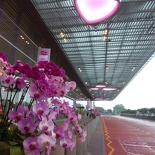
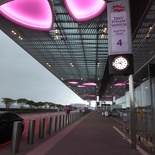
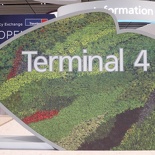
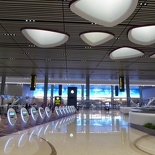
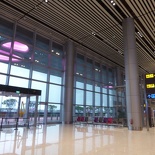
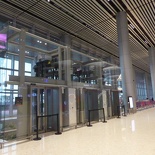

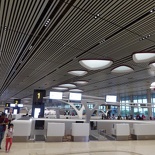
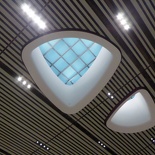
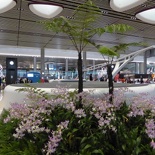
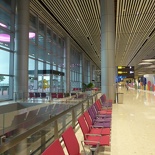
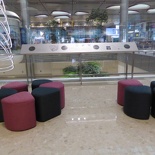
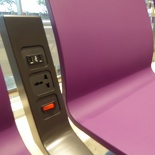
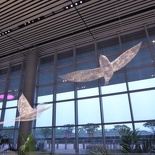
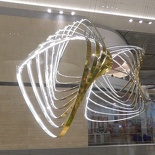
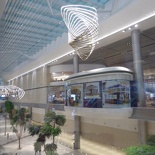
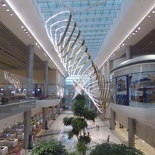
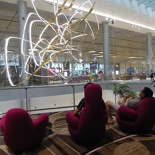
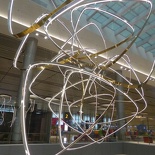
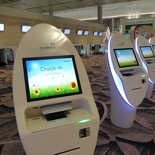
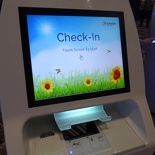
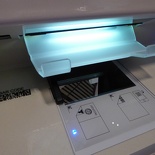
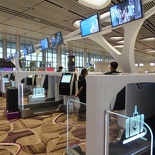
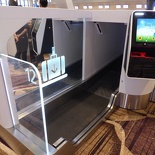
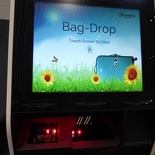
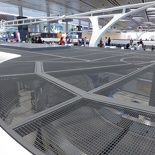
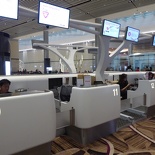
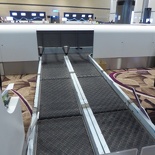
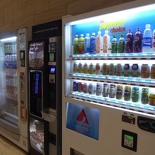
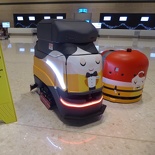
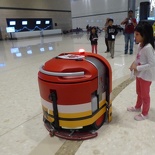
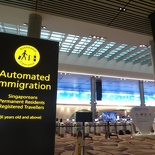
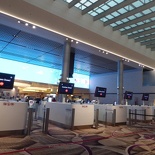
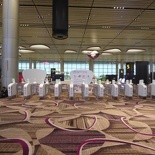
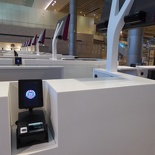
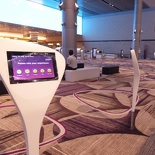
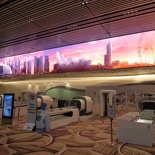

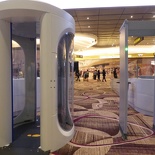
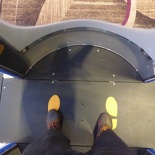
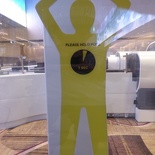
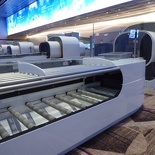
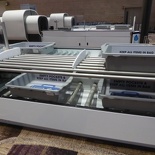
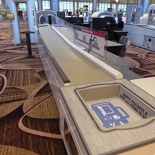
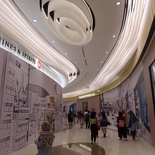
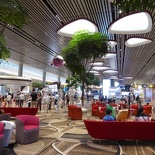
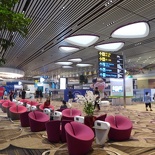

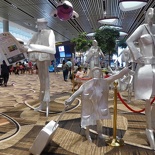
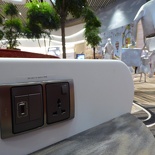
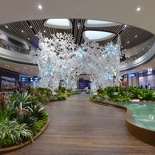
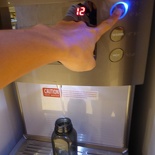
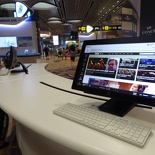
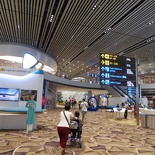
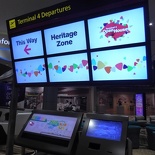
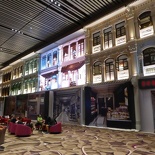
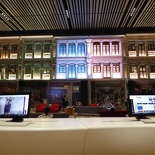
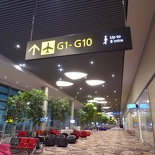
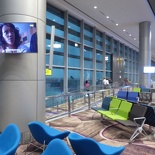
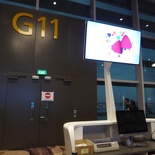
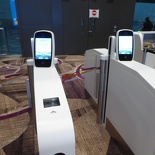
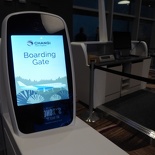
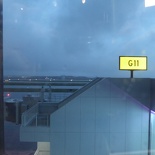
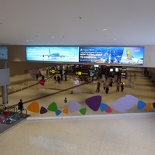

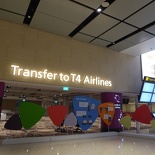
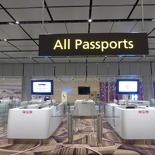
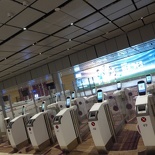
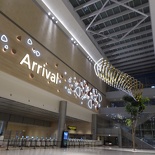
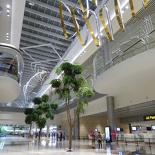
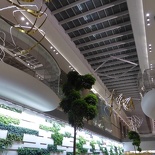
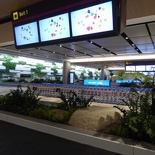
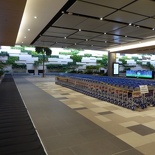
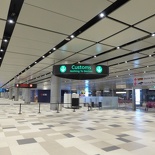
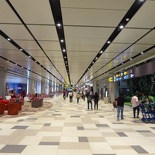
Awesome article on my favourite airport period. Changi amazes me everytime I’m there, with new things to see and explore. It’s a mini town by itself and it never sleeps. There’s just too much to do and time zips pass just too fast @ Changi without you realising. Changi spoils me rotten and tires me out. With Terminal 4 and Jewel@Changi in the pipeline, much more is in-store and you might need to stay a day longer just to enjoy the new facilities.
Happy blogging and transiting. ❤